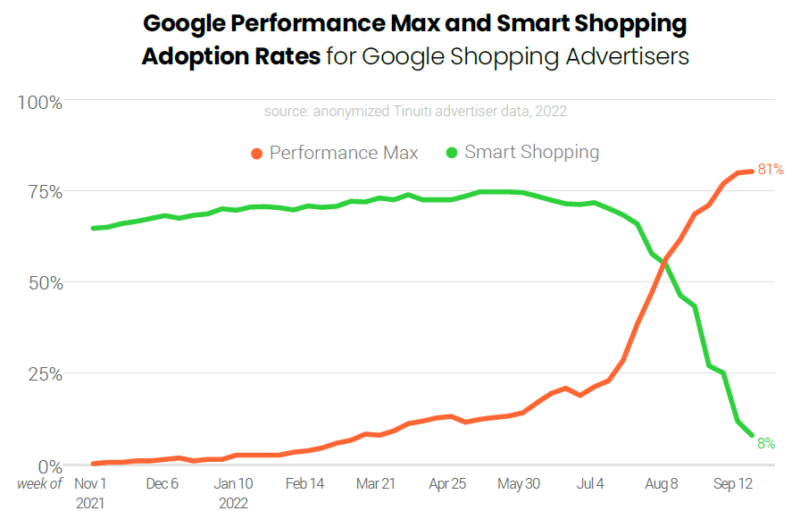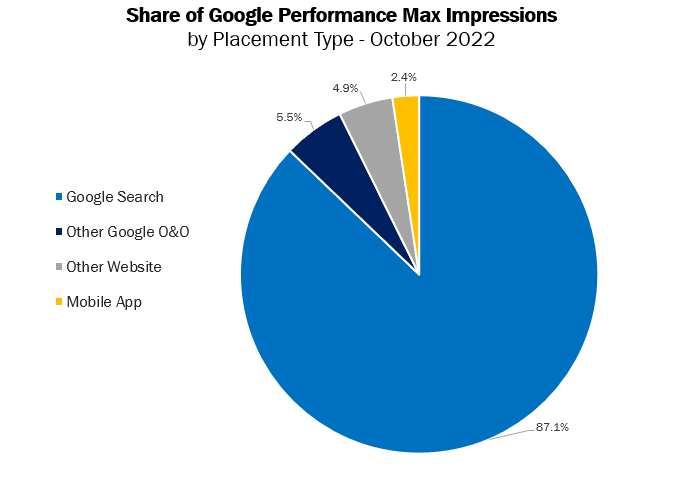Many brands, particularly SMBs, have relied exclusively on Smart Shopping campaigns to appear in Google Shopping ad listings.
Thus, Google’s Q3 2022 transition from Smart Shopping to Performance Max (PMax) campaigns carried high stakes.
Fortunately, if results from Tinuiti advertisers are a good indicator, the transition process appeared to run briskly and smoothly for most.
As retailers look ahead to the critical Q4 holiday shopping season, let’s examine how Performance Max has performed so far and what may lie ahead as we close out the year.
How Performance Max adoption rates have trended over the past year
Prior to Google automatically transitioning Smart Shopping campaigns to PMax campaigns in July 2022:
- About three in four Tinuiti clients running Google Shopping ads were using Smart Shopping campaigns.
- Just 20% were running Performance Max campaigns.
At the time, most brands that did run PMax campaigns also continued to run Smart Shopping campaigns.

Performance Max adoption rates jumped sharply toward the end of July as Google’s transition ramped up and then surpassed those for Smart Shopping in early August.
By the end of August, fully two-thirds of Smart Shopping advertisers had completely transitioned to PMax campaigns.
Only a small share of brands saw any traffic from Smart Shopping by mid-September.
Performance Max share of clicks, conversions, impressions and spend climbed in tandem
As more and more traffic flowed to PMax campaigns over July and August, it was remarkable how similarly PMax's share of total PMax and Smart Shopping clicks and conversions trended.
In other words, advertisers didn't see a sharp uptick in low-quality clicks that converted relatively poorly.

Adding cost or impression share to the above graph would be superfluous as both lines would also overlap nearly identically with the lines for clicks and conversions.
Again, if Performance Max campaigns were drawing in significantly different inventory than the Smart Shopping campaigns they replaced, we might expect PMax to quickly pick up impression share more than cost or conversion share – but that didn't happen for the average brand.
Performance Max impressions from non-Google placements are modest so far
This data is not the result of Tinuiti trying to "hack" Performance Max campaigns to behave just like standard Shopping campaigns or Smart Shopping campaigns.
Rather, our recommended approach is to use PMax to complement existing Search and Shopping campaigns.
Even with doing that and providing the necessary creative assets for PMax to reach incremental inventory, most brands are seeing Google search produce the bulk of ad impressions for PMax campaigns.

In October, Tinuiti clients saw:
- Google search account for 87% of Performance Max impressions, on average.
- Other Google-owned and -operated properties produced 5.5% of PMax impressions.
- Other websites accounted for 4.9%.
- Mobile apps produced 2.4%.
Interestingly, the two most commonly observed websites in Google's placement report for PMax campaigns are yahoo.com and msn.com.
Google notes its placement reports may not always be comprehensive. However, its help page from September – announcing all Smart Shopping campaigns created in Merchant Center had been transitioned to Performance Max – mentions that beta testers of PMax campaigns had seen a 12% lift in conversion value compared to Smart Shopping.

That would be a great deal if it pans out for everyone else, but Google isn't quite promising the world with this change.
The bigger picture for Google and Performance Max
Beyond assessing that the typical advertiser didn't see a big jump in conversion share for PMax campaigns during the transition (relative to PMax's share of clicks, cost, and impressions), it's a little difficult to judge how well Google might think the transition is going.
Taking a broader view of Google's advertising business, revenue growth has been slowing since Q2 2021, which was a blowout quarter for Google's business as it bounced back against weak year-ago comparisons from the early months of the pandemic.
At Tinuiti, we saw Google Shopping spending growth decelerate from 26% Y/Y in Q2 2022 to 19% in Q3. But this is against that historical backdrop and ongoing concern over inflation and a potential recession ahead.
Ultimately, it's unlikely that the Performance Max transition was ever going to, or even meant to, immediately move the needle much for Google.
Instead, I'd bet Google is happy that most advertisers didn't see major hiccups ahead of the holiday season and that it doesn't want to rock the boat too much before the end of the year.
Google was able to transition brands to a new model that will allow them to bring greater automation to ads across search and other properties going forward. Thus, they can increment more when the stakes are lower.
The post Performance Max transition: Key trends for Google advertisers appeared first on Search Engine Land.
source https://searchengineland.com/pmax-transition-key-trends-google-advertisers-389456

0 Comments